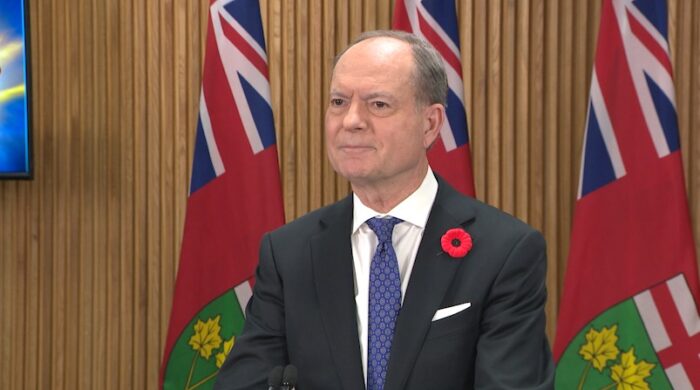
LATEST STORIES:


Thursday’s so-called “mini budget” offered a glimpse into Ontario’s economic state, but it offered few new funding announcements.
Just two days after the federal budget was tabled, Ontario released its fall economic statement.
Ontario’s Finance Minister Peter Bethlenfalvy is projecting a shrinking deficit, but also shrinking expectations for the province’s housing starts and labour market, as American tariffs continue hitting the economy.
When asked what Ontarians can look forward to from this statement, the finance minister said it’s a continuation of the plan the Progressive Conservatives were elected on in the winter.
“This year’s fall economic statement is more than just an update on our government’s plan to protect Ontario,” said Bethlenfalvy. “It’s a reminder — a reminder that, in the face of enormous challenges, our nation must stay the course.”
Ontario’s finance minister presented his fall economic statement at Queen’s Park Thursday, saying the province is looking to keep a steady fiscal hand on the economy amid the uncertainty of U.S. tariffs.
In terms of the deficit, the province had positive news to share.
Ontario expects to end the year $13.5 billion in the red — better than the $14.6 billion they had projected.
The mini-budget still has the province planning to balance the books by 2027-28.
“These trying times demand we maintain a steady fiscal hand and work to restore balance,” said Bethlenfalvy.
But in terms of new spending, the government is keeping a relatively tight pocket book.
Most initiatives noted in the statement have previously been announced, or were featured in the spring budget.
The province is promising to add $100 million to a fund that helps small and medium sized businesses find customers and supply chains outside of the United States.
It also says there will soon be announcements about doling out the remaining $4 billion from the Protecting Ontario Fund to support steel, aluminum and other industries targeted by U.S. tariffs.
While the statement reiterated the Ford government’s announcement to axe provincial tax for some first-time home buyers, it also shows the province is lagging on its goal to build 1.5 Million homes this decade.
READ MORE: Ontario eyes challenging labour market amid tariffs, lower population growth
Housing starts are now only expected to hit just over 64,000 for the year, lower than the projected 72,000.
When asked about the delay, Bethlenfalvy said the 1.5 million goal has “softened.”
“That target is no longer a hard target, but we’re going to continue to build as many homes as we can,” said Bethlenfalvy.
Ontario Premier Doug Ford gave his approval to the finance minister, saying “another great job from the best finance minister this province ever had.”
The opposition, however, took issue with the lack of new spending to support Ontario amid tariff uncertainty and unemployment, specifically when it comes to spending on education and healthcare — neither of which got a boost in this mini-budget.
“This plan isn’t even worth the paper it’s printed on,” said the NDP Leader of Ontario Marit Stiles. “They are not taking into account inflation or population growth, so what this amounts to is a cut. It’s a cut to education, to health care, to long term care.”
“There’s no real relief when it comes to affordability, no real relief for our schools, for our hospitals,” said the Liberal Parliamentary Leader John Fraser. “That’s why we’re calling on the government right now to spend $1 billion dollars stabilizing our hospitals.”
“The bottom line is: people can’t afford to live in Ontario,” said Ontario’s Green Party Leader Mike Schreiner, “and the fall economic statement will only make it worse.”
The province does also plan to move forward with its controversial and costly tunnel underneath Highway 401.
The minister says they’ve awarded the contract to a company for the feasibility study, but says we’ll have to wait for the next quarter’s statement and the spring budget for a full picture of how much it’s all going to cost.
WATCH MORE: Ontario finance minister set to table fall fiscal update